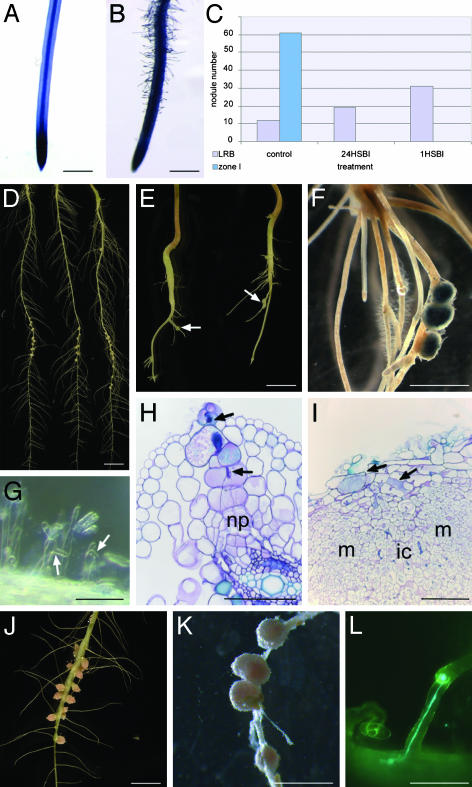Fig. 2.
Comparison of root morphology and nodulation traits between hydroponically and vermiculite-grown S. rostrata and N. plena plants. (A and B) Methylene blue-stained root tip of hydroponically and vermiculite-grown S. rostrata root, respectively. No root hairs are detected on the hydroponically grown root tip, whereas the vermiculite-grown root contains plenty. (C) Influence of submersion on lateral root base and zone I nodule numbers of vermiculite-grown S. rostrata roots. The nodule number is derived from lateral root base or zone I nodulation, 7 DPI on vermiculite-grown roots (control), on vermiculite-grown roots that were submerged 24 h before inoculation (24HSBI), and 1 h before inoculation (1HSBI). (D) Nodulated hydroponic roots, 7 DPI. Nodules are located at lateral root bases. (E) Nodulated hydroponic root, grown in the presence of AVG, 7 DPI. Nodules are distributed over the root (arrows). (F) Hydroponic root grown in the presence of AVG, infected with ORS571(pRG960SD-32), and stained for GUS. (G) Root hair deformation and curling on hydroponically grown roots in the presence of AVG, 2 DPI. Arrows mark curled and deformed root hairs. (H and I) Toluidine blue-stained sections of developing nodules on hydroponic roots grown in the presence of AVG. Arrows indicate intracellular infection thread (H) and small infection pockets (I). (J) Hydroponically grown nodulated N. plena roots, 7 DPI. Nodules are present at lateral root bases. (K) Vermiculite-grown nodulated N. plena root. Nodules are distributed over the root. (L) Curled N. plena root hair containing an infection thread visualized by GFP-containing Rhizobium sp. DUS239. Abbreviations, see Fig. 1 legend; np, nodule primordium. (Bars = 1 cm in A, B, D–F, J, and K and 100 μm in G–I and L.)

